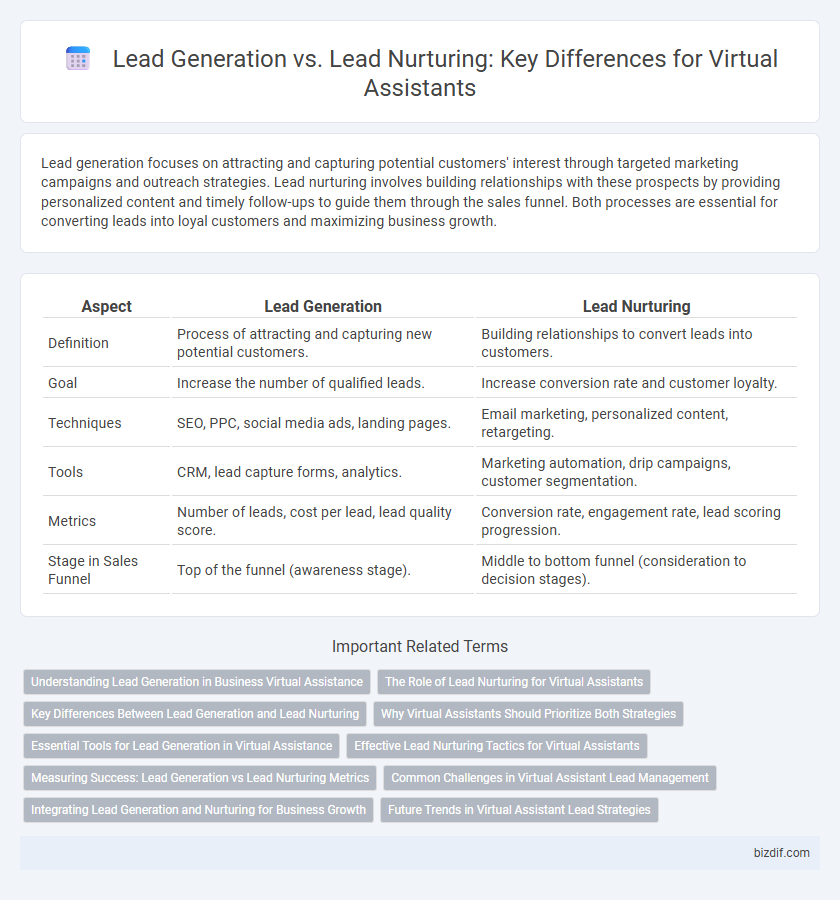Lead generation focuses on attracting and capturing potential customers' interest through targeted marketing campaigns and outreach strategies. Lead nurturing involves building relationships with these prospects by providing personalized content and timely follow-ups to guide them through the sales funnel. Both processes are essential for converting leads into loyal customers and maximizing business growth.
Table of Comparison
| Aspect | Lead Generation | Lead Nurturing |
|---|---|---|
| Definition | Process of attracting and capturing new potential customers. | Building relationships to convert leads into customers. |
| Goal | Increase the number of qualified leads. | Increase conversion rate and customer loyalty. |
| Techniques | SEO, PPC, social media ads, landing pages. | Email marketing, personalized content, retargeting. |
| Tools | CRM, lead capture forms, analytics. | Marketing automation, drip campaigns, customer segmentation. |
| Metrics | Number of leads, cost per lead, lead quality score. | Conversion rate, engagement rate, lead scoring progression. |
| Stage in Sales Funnel | Top of the funnel (awareness stage). | Middle to bottom funnel (consideration to decision stages). |
Understanding Lead Generation in Business Virtual Assistance
Lead generation in business virtual assistance involves identifying and attracting potential customers through targeted outreach strategies and data analysis. Virtual assistants streamline this process by managing CRM systems, conducting market research, and qualifying leads to boost conversion rates. Effective lead generation lays the foundation for successful sales funnels and increases ROI for businesses leveraging virtual support.
The Role of Lead Nurturing for Virtual Assistants
Lead nurturing plays a crucial role for virtual assistants by fostering strong relationships with potential clients through personalized communication and timely follow-ups. Unlike lead generation, which focuses on attracting new prospects, lead nurturing involves guiding leads through the sales funnel to increase conversion rates and client retention. Virtual assistants utilize lead nurturing strategies such as automated email sequences and CRM management to maintain engagement and build trust effectively.
Key Differences Between Lead Generation and Lead Nurturing
Lead generation focuses on attracting and capturing potential customer information through strategies such as content marketing, social media campaigns, and landing pages, aiming to increase the sales funnel's top. Lead nurturing involves building relationships with prospects via personalized email sequences, targeted content, and engagement tactics to convert leads into loyal customers over time. Key differences include lead generation's emphasis on quantity and initial contact, while lead nurturing prioritizes quality, trust-building, and ongoing communication throughout the buyer's journey.
Why Virtual Assistants Should Prioritize Both Strategies
Virtual assistants should prioritize both lead generation and lead nurturing to maximize business growth and client retention. Effective lead generation expands the potential customer base, while consistent lead nurturing builds trust and increases conversion rates over time. Balancing these strategies enhances overall sales performance and ensures a sustainable pipeline of qualified leads.
Essential Tools for Lead Generation in Virtual Assistance
Effective lead generation in virtual assistance relies on essential tools such as CRM software, email marketing platforms, and AI-powered chatbots that streamline prospect identification and initial engagement. These tools enable virtual assistants to capture, organize, and analyze lead data for targeted outreach and improved conversion rates. Integrating analytics tools further enhances lead qualification by providing insights into customer behavior and campaign performance.
Effective Lead Nurturing Tactics for Virtual Assistants
Effective lead nurturing tactics for virtual assistants include personalized email campaigns that address specific client needs and interests, increasing engagement and trust. Utilizing CRM tools to track interactions and automate follow-ups ensures timely communication, enhancing the potential for conversion. Providing valuable content such as webinars, case studies, and tailored recommendations helps maintain relationships and guides leads smoothly through the sales funnel.
Measuring Success: Lead Generation vs Lead Nurturing Metrics
Lead generation success is measured by metrics such as the number of new leads acquired, conversion rates from visitor to lead, and cost per lead, reflecting the effectiveness of initial contact strategies. Lead nurturing metrics focus on engagement levels, email open and click-through rates, lead scoring progression, and the percentage of leads converted to sales-qualified status, highlighting the quality and readiness of leads for sales. Tracking these distinct metrics enables businesses to optimize both the acquisition and development stages of the customer journey for improved ROI.
Common Challenges in Virtual Assistant Lead Management
Virtual assistants managing lead generation often face challenges in accurately qualifying prospects and segmenting data for targeted outreach. In lead nurturing, maintaining personalized communication and timely follow-ups proves difficult without advanced CRM integration and automation. Balancing both processes requires seamless coordination to prevent lead attrition and maximize conversion rates.
Integrating Lead Generation and Nurturing for Business Growth
Integrating lead generation and lead nurturing enhances business growth by creating a seamless customer acquisition process that attracts qualified prospects and engages them with personalized content. Virtual assistants streamline this integration by automating data collection, managing follow-ups, and delivering timely, customized interactions that boost conversion rates. Combining these strategies ensures continuous engagement, turning potential leads into loyal customers and increasing overall revenue.
Future Trends in Virtual Assistant Lead Strategies
Virtual assistants are revolutionizing lead generation by leveraging AI-powered data analytics and personalized outreach to identify high-quality prospects faster. Future trends emphasize integrating machine learning algorithms to enhance lead nurturing through real-time customer interaction analysis and automated follow-ups. Enhanced natural language processing enables virtual assistants to deliver hyper-personalized engagement, increasing conversion rates and streamlining the sales funnel.
Lead generation vs Lead nurturing Infographic

 bizdif.com
bizdif.com